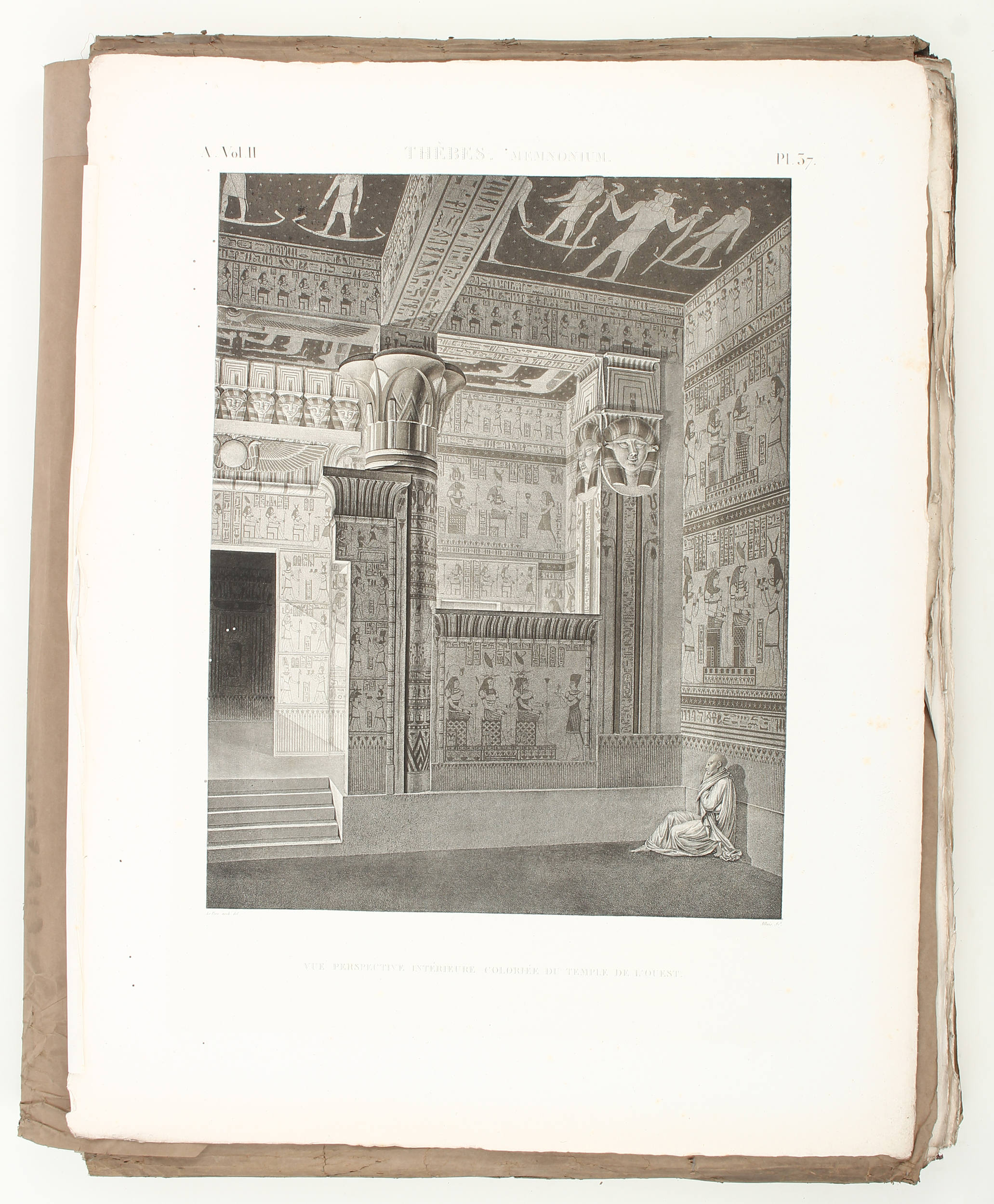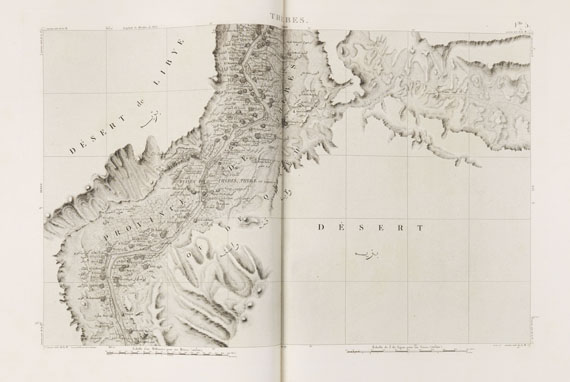EGYPT -- Description de l'Egypte ou Recueil des observations et des recherches qui ont été faites en Egypte pendant l'expédition de l'Egypte. Paris: Panckoucke, 1820-1830. 37 (0f 38) volumes, comprising 24 text volumes bound in 26 (vol. 18 in three parts), 8° (208 x 128mm), and 11 (of 12) volumes of plates, 2° (700 x 523mm), lacking the elephant folio volume of large-format plates. Two engraved frontispieces, one coloured, and 848 (of 888) engraved plates, text volumes with 47 engraved plates and maps and 34 tables. Blindstamps of the expedition throughout. (Occasional spotting.) Contemporary red sheep-backed boards, flat spines ruled and lettered in gilt, sprinkled edges (some minor scuffing). A HANDSOME SET OF THE SECOND EDITION OF THE FIRST COMPREHENSIVE DESCRIPTION OF ANCIENT AND MODERN EGYPT, AND AN OUTSTANDING ACHIEVEMENT OF NAPOLEON'S EXPEDITION TO EGYPT (1798-1801). The work is the greatest of a number of outstanding scientific publications by the French government detailing the results of exploration, unequalled by any other nation during the same period. The only flaw in Napoleon's preparation for the invasion of Egypt was the miscalculation of the Turkish reaction to France's unsolicited 'help' in sorting out its most unruly vassals, the Mamluks of Egypt. Napoleon had intended to follow his military conquest of the country with the introduction of radical economic and social measures which might have created a modern European-style state, controlled by France, at the axis of all trade between Europe, India and the East. To this end nearly 500 French civilians were dispatched to Egypt, led by men drawn from the Institut de France , and known popularly as the savants . On arrival their first task was to make a thorough survey of every aspect of the country, including its vast wealth of antiquities. The work was co-ordinated by the Institut de l'Egypte , founded in the house of Hassan Kachef (illustrated in the plates to the Etat moderne ), with Gaspar Monge as president. As early as October 1798 Fournier was entrusted with the task of uniting the reports on various disciplines with a view to publication. Following the capitulation of the army to Egypt under General Menou (a convert to Islam), the savants returned to France where a commission was set up for the editing and supervision of the work; its publication stretched over 20 years and was finally completed in 1830. The set comprises: Antiquités : Text: 10 vols. Plates: 5 volumes with engraved dedication plate to Louis XVIII, engraved coloured frontispiece, and 378 (of 419) plates, including 45 double or folding. This edition does not contain plates a-f, not listed in the 'table de planches' in the last text volume for this part. The large map was outside the plate count in the first edition but here is plate 1 in volume 1. This part describes not only the ruins, with which Europeans were already familiar, but also the objects excavated there, including the Rosetta Stone. This collection of portable objects was to have been removed to France but at embarkation William Hamilton (agent to Lord Elgin) and E.D. Clarke confiscated them; the majority survive today at the British Museum. The quality of the plates was much enhanced by the use of an engraving machine invented by Conté, which is itself illustrated in the succeeding part. Etat Moderne : Text: 10 vols. (publ. as tomes 11-18; tome 18 in three parts). Plates: 2 vols. with 173 (of 182) engraved plates, including one double-page. This part describes the architecture of Egypt, particularly Cairo, subsequent to the Arab invasion in the 7th century. Other sections detail Arts et Métiers, Costumes et Portraits, Vases, Meubles et Instruments, Inscriptions Monnoies et Médailles . Histoire Naturelle : Text: 6 vols. Plates: 3 vols. (numbered 1, 2 and 2bis) with 244 (of 245) engraved plates. The principal sections of this part comprise geology and physical geography by de Rozière, mammals by Geoffroy-Saint-Hilair
EGYPT -- Description de l'Egypte ou Recueil des observations et des recherches qui ont été faites en Egypte pendant l'expédition de l'Egypte. Paris: Panckoucke, 1820-1830. 37 (0f 38) volumes, comprising 24 text volumes bound in 26 (vol. 18 in three parts), 8° (208 x 128mm), and 11 (of 12) volumes of plates, 2° (700 x 523mm), lacking the elephant folio volume of large-format plates. Two engraved frontispieces, one coloured, and 848 (of 888) engraved plates, text volumes with 47 engraved plates and maps and 34 tables. Blindstamps of the expedition throughout. (Occasional spotting.) Contemporary red sheep-backed boards, flat spines ruled and lettered in gilt, sprinkled edges (some minor scuffing). A HANDSOME SET OF THE SECOND EDITION OF THE FIRST COMPREHENSIVE DESCRIPTION OF ANCIENT AND MODERN EGYPT, AND AN OUTSTANDING ACHIEVEMENT OF NAPOLEON'S EXPEDITION TO EGYPT (1798-1801). The work is the greatest of a number of outstanding scientific publications by the French government detailing the results of exploration, unequalled by any other nation during the same period. The only flaw in Napoleon's preparation for the invasion of Egypt was the miscalculation of the Turkish reaction to France's unsolicited 'help' in sorting out its most unruly vassals, the Mamluks of Egypt. Napoleon had intended to follow his military conquest of the country with the introduction of radical economic and social measures which might have created a modern European-style state, controlled by France, at the axis of all trade between Europe, India and the East. To this end nearly 500 French civilians were dispatched to Egypt, led by men drawn from the Institut de France , and known popularly as the savants . On arrival their first task was to make a thorough survey of every aspect of the country, including its vast wealth of antiquities. The work was co-ordinated by the Institut de l'Egypte , founded in the house of Hassan Kachef (illustrated in the plates to the Etat moderne ), with Gaspar Monge as president. As early as October 1798 Fournier was entrusted with the task of uniting the reports on various disciplines with a view to publication. Following the capitulation of the army to Egypt under General Menou (a convert to Islam), the savants returned to France where a commission was set up for the editing and supervision of the work; its publication stretched over 20 years and was finally completed in 1830. The set comprises: Antiquités : Text: 10 vols. Plates: 5 volumes with engraved dedication plate to Louis XVIII, engraved coloured frontispiece, and 378 (of 419) plates, including 45 double or folding. This edition does not contain plates a-f, not listed in the 'table de planches' in the last text volume for this part. The large map was outside the plate count in the first edition but here is plate 1 in volume 1. This part describes not only the ruins, with which Europeans were already familiar, but also the objects excavated there, including the Rosetta Stone. This collection of portable objects was to have been removed to France but at embarkation William Hamilton (agent to Lord Elgin) and E.D. Clarke confiscated them; the majority survive today at the British Museum. The quality of the plates was much enhanced by the use of an engraving machine invented by Conté, which is itself illustrated in the succeeding part. Etat Moderne : Text: 10 vols. (publ. as tomes 11-18; tome 18 in three parts). Plates: 2 vols. with 173 (of 182) engraved plates, including one double-page. This part describes the architecture of Egypt, particularly Cairo, subsequent to the Arab invasion in the 7th century. Other sections detail Arts et Métiers, Costumes et Portraits, Vases, Meubles et Instruments, Inscriptions Monnoies et Médailles . Histoire Naturelle : Text: 6 vols. Plates: 3 vols. (numbered 1, 2 and 2bis) with 244 (of 245) engraved plates. The principal sections of this part comprise geology and physical geography by de Rozière, mammals by Geoffroy-Saint-Hilair







.jpg)




.jpg)
.jpg)
.jpg)
Try LotSearch and its premium features for 7 days - without any costs!
Be notified automatically about new items in upcoming auctions.
Create an alert